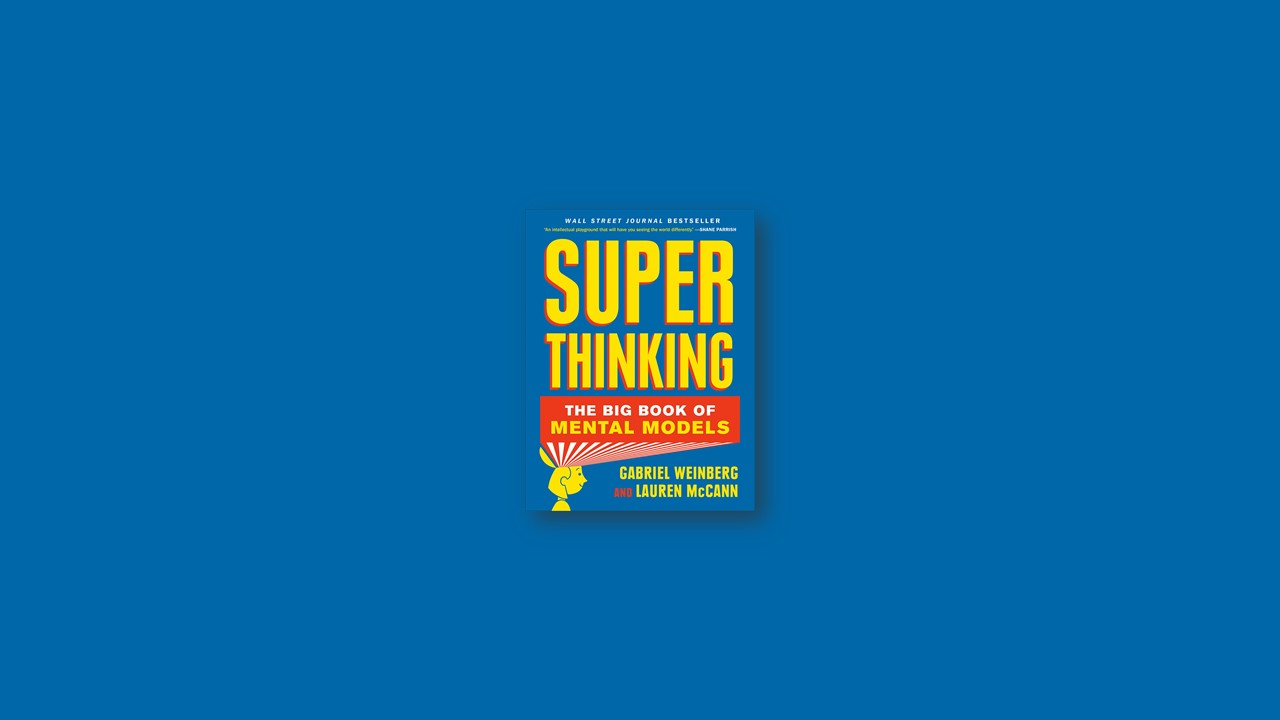Don’t Trust Your Gut
You probably do not have the right experience intuitively to handle everything that life throws at you, and so you should be especially wary of your intuition in any new or unfamiliar situation. For example, if you’re an experienced hiker in bear country, you know that you should never stare down a bear, as it will take this as a sign of aggression and may charge you in response. Suppose now you’re hiking in mountain lion country and you come across a lion—what should you do? Your intuition would tell you not to stare it down, but in fact, you should do exactly that. To mountain lions, direct eye contact signals that you aren’t easy prey, and so they will hesitate to attack.
At the same time, intuition can help guide you to the right answer much more quickly. For example, the more you work with mental models, the more your intuition about which one to use in a given situation will be right, and the faster you will get to better decisions working with these models.
To avoid mental traps, you must think more objectively. Try arguing from first principles, getting to root causes, and seeking out the third story.
Realize that your intuitive interpretations of the world can often be wrong due to availability bias, fundamental attribution error, optimistic probability bias, and other related mental models that explain common errors in thinking.
Use Ockham’s razor and Hanlon’s razor to begin investigating the simplest objective explanations. Then test your theories by de-risking your assumptions, avoiding premature optimization.
Attempt to think gray in an effort to consistently avoid confirmation bias.
Actively seek out other perspectives by including the Devil’s advocate position and bypassing the filter bubble. Consider the adage “You are what you eat.” You need to take in a variety of foods to be a healthy person. Likewise, taking in a variety of perspectives will help you become a super thinker.
Too Much of a Good Thing
In any situation where you can spot spillover effects (like a polluting factory), look for an externality (like bad health effects) lurking nearby. Fixing it will require intervention either by fiat (like government regulation) or by setting up a marketplace system according to the Coase theorem (like cap and trade).
Public goods (like education) are particularly susceptible to the tragedy of the commons (like poor schools) via the free rider problem (like not paying taxes).
Beware of situations with asymmetric information, as they can lead to principal-agent problems.
Be careful when basing rewards on measurable incentives, because you are likely to cause unintended and undesirable behavior (Goodhart’s law).
Short-termism can easily lead to the accumulation of technical debt and create disadvantageous path dependence; to counteract it, think about preserving optionality and keep in mind the precautionary principle.
Internalize the distinction between irreversible and reversible decisions, and don’t let yourself succumb to analysis paralysis for the latter.
Shortcut Your Way to Success
Choose activities to work on based on their relevance to your north star.
Focus your time on just one of these truly important activities at a time (no multitasking!), making it the top idea on your mind.
Select between options based on opportunity cost models.
Use the Pareto principle to find the 80/20 in any activity and increase your leverage at every turn.
Recognize when you’ve hit diminishing returns and avoid negative returns.
Use commitment and the default effect to avoid present bias, and periodic evaluations to avoid loss aversion and the sunk-cost fallacy.
Look for shortcuts via existing design patterns, tools, or clever algorithms. Consider whether you can reframe the problem.
Order Out of Chaos
Adopt an experimental mindset, looking for opportunities to run experiments and apply the scientific method wherever possible.
Respect inertia: create or join healthy flywheels; avoid strategy taxes and trying to enact change in high-inertia situations unless you have a tactical advantage such as discovery of a catalyst and a lot of potential energy.
When enacting change, think deeply about how to reach critical mass and how you will navigate the technology adoption life cycle.
Use forcing functions to grease the wheels for change.
Actively cultivate your luck surface area and put in work needed to not be subsumed by entropy.
When faced with what appears to be a zero-sum or black-and-white situation, look for additional options and ultimately for a win-win.
Will It Replicate?
Avoid succumbing to the gambler’s fallacy or the base rate fallacy.
Anecdotal evidence and correlations you see in data are good hypothesis generators, but correlation does not imply causation—you still need to rely on well-designed experiments to draw strong conclusions.
Look for tried-and-true experimental designs, such as randomized controlled experiments or A/B testing, that show statistical significance.
The normal distribution is particularly useful in experimental analysis due to the central limit theorem. Recall that in a normal distribution, about 68 percent of values fall within one standard deviation, and 95 percent within two.
Any isolated experiment can result in a false positive or a false negative and can also be biased by myriad factors, most commonly selection bias, response bias, and survivorship bias.
Replication increases confidence in results, so start by looking for a systematic review and/or meta-analysis when researching an area.
Always keep in mind that when dealing with uncertainty, the values you see reported or calculate yourself are uncertain themselves, and that you should seek out and report values with error bars!
Beware of Unknown Unknowns
When tempted to use a pro-con list, consider upgrading to a cost-benefit analysis or decision tree as appropriate.
When making any quantitative assessment, run a sensitivity analysis across inputs to uncover key drivers and appreciate where you may need to seek greater accuracy in your assumptions. Pay close attention to any discount rate used.
Beware of black swan events and unknown unknowns. Use systems thinking and scenario analysis to more systematically uncover them and assess their impact.
For really complex systems or decision spaces, consider simulations to help you better assess what may happen under different scenarios.
Watch out for blind spots that arise from groupthink. Consider divergent and lateral thinking techniques when working with groups, including seeking more diverse points of view.
Strive to understand the global optimum in any system and look for decisions that move you closer to it.
Endgame
Analyze conflict situations through a game-theory lens. Look to see if your situation is analogous to common situations like the prisoner’s dilemma, ultimatum game, or war of attrition.
Consider how you can convince others to join your side by being more persuasive through the use of influence models like reciprocity, commitment, liking, social proof, scarcity, and authority. And watch out for how they are being used on you, especially through dark patterns.
Think about how a situation is being framed and whether there is a way to frame it that better communicates your point of view, such as social norms versus market norms, distributive justice versus procedural justice, or an appeal to emotion.
Try to avoid direct conflict because it can have uncertain consequences. Remember there are often alternatives that can lead to more productive outcomes. If diplomacy fails, consider deterrence and containment strategies.
If a conflict situation is not in your favor, try to change the game, possibly using guerrilla warfare and punching-above-your-weight tactics.
Be aware of how generals always fight the last war, and know your best exit strategy.
Together We Thrive
People are not interchangeable. They come from a variety of backgrounds and with a varied set of personalities, strengths, and goals. To be the best manager, you must manage to the person, accounting for each individual’s unique set of characteristics and current challenges.
Craft unique roles that amplify each individual’s strengths and motivations. Avoid the Peter principle by promoting people only to roles in which they can succeed.
Properly delineate roles and responsibilities using the model of DRI (directly responsible individual).
People need coaching to reach their full potential, especially at new roles. Deliberate practice is the most effective way to help people scale new learning curves. Use the consequence-conviction matrix to look for learning opportunities, and use radical candor within one-on-ones to deliver constructive feedback.
When trying new things, watch out for common psychological failure modes like impostor syndrome and the Dunning-Kruger effect.
Actively define group culture and consistently engage in winning hearts and minds toward your desired culture and associated vision.
If you can set people up for success in the right roles and well-defined culture, then you can create the environment for 10x teams to emerge.
Activate Your Force Field
Find a secret and build your career or organization around it, searching via customer development for product/market fit (or another “fit” relevant to the situation).
Strive to be like a heat-seeking missile in your search for product/market fit, deftly navigating the idea maze. Look for signs of hitting a resonant frequency for validation.
If you can’t find any bright spots in what you’re doing after some time, critically evaluate your position and consider a pivot.
Build a moat around yourself and your organization to create sustainable competitive advantage.
Don’t get complacent; remember only the paranoid survive, and keep on the lookout for disruptive innovations, particularly those with a high probability of crossing the chasm.


